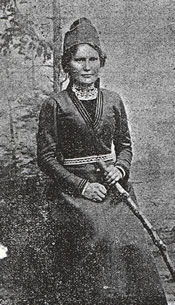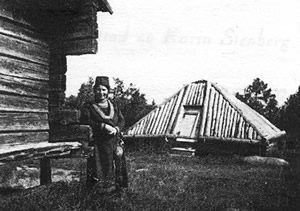|
The Pioneers: Elsa Laula And Karin Stenberg, The First Sámi Woman Writers
Vuokko Hirvonen, Ph.D.
 |
| Elsa Laula |
The writing history of Sámi women is much shorter than men's: it was not until the beginning of 1900s
that the first women writers appeared. The first writing women, Elsa Laula (1877-1931, later known as
Elsa Laula Renberg) and Karin Stenberg (1884-1969), were both born at the end of the 19th century and
came from the southern Sámi-speaking region of Sweden, into which the colony rapidly expanded.
They saw in their own lives how the traditional Sámi society was beginning to break down. Their
political writing was clearly connected with the ethnic movement of the Sámi and simultaneously
with a new way of representing the Sámi.
Social action sprung up among the Sámi in the early 1900s. At that time national romantic ideas were
sweeping through Scandinavia; these awakened Sámi self-esteem and the Sámi began to resist
the attempts of the different states to assimilate them. Elsa Laula, the first Sámi woman writer
we know, was one of those activists. Laula had attended secondary school in örebro and after that she
went to be educated as a midwife in Stockholm. She wrote a pamphlet of 30 pages, Inför Lif eller Död?
- Sanningsord i de Lappska Förhållanderna [Do we face life or death? Words of truth for the Lappish
situation], in Swedish, in which she urged the Sámi to demand their rights to land and also discusses
how her people could survive the Swedish cultural assimilation policy. She felt that an important task
was to encourage Sámi women to organization work. She founded the first Sámi women's organization,
"Brurskanke samiske kvindeforening" [Brurskanke Sámi Women's League] on December 5, 1910. Sámi
woman over fifteen were permitted to join this organisation. According to the first paragraph the mission
of the organisation was to establish a children's school in Nordland in Norway, and generally to give
information to Sámi people. As an achievement of this organisation, the first all-Nordic Sámi
conference was held in Trondheim, Norway in 1917. [1] In connection with the announcement
of the meeting there was a special request for Sámi women to attend the meeting: "Not a single
woman should be lacking at this meeting. We believe that when Sámi women join together a great
aim in their eyes is to work for their people, and they soon find the way to influence people to attain
this goal." Elsa Laula Renberg also wrote frequently to newspapers.
In her work Elsa Laula made use of both ethnicity and gender. She saw the situation of the Sámi people
as a minority and she wanted to change the majority's policy to something more affirmative towards the
Sámi people. Many of the matters she raised are still not completely settled. She considered women
as a positive force when promoting matters. That is why she founded women's organisations and encouraged
women to use their own power to remove social unfairness. Following in the tradition of Laula Renberg,
a new Sámi women's organisation, Sáráhkká, was founded in 1989. [2] The
purposes of the organisation are to promote equality, to reach social fairness, and above all, to bring
into view women's culture and to achieve more respect for Sámi women. In addition, the organisation
cooperates with regional as well as other indigenous women's organisations.
 |
| Karin Stenberg |
Laula Renberg's college teacher Karin Stenberg also wrote a pamphlet called Dah läh mijen situd (This
Is Our Will) with the members of the Arjeplog Sámi association and it was published in 1920. The
aim of this book was to give more information about the Sámi people living in Sweden, at a time
when social Darwinist ideas were also influencing Swedish society. These ideas were concretised as racist
opinions towards Sámi people and traditional life conditions were threatened. Both Laula and Stenberg
were working as social agents and they were criticising both in public and in their pamphlets the rights
of the majority people to rule and subordinate the Sámi people. This kind of policy one can call
with the concepts of Stuart Hall "the politics of representation." [3] According to Hall,
it means that the relation of centre and margin is changed. There is need to represent marginalised people
with a new status, which differs from that where the ruling discourse has placed its subjects. As we see,
these women were struggling against the ruling discourse and wanted the Sámi people to represent
themselves by the means of their own associations, and at the same time by writing political pamphlets
which were aimed at the majority. From our point of view today we can call this postcolonial writing.
Writers belonging to the following generations of grandmothers, mothers and daughters have continued the
tradition started by Laula and Stenberg.
References
[1] The opening day of this conference, February 6th, was declared the Sámi "national"
day at the 15th Sámi Conference held in Helsinki in 1992-Editor's note. See February 6th - The
National Day of the Sámi: A symbol of cooperation and unity at http://www.samediggi.fi/oktavuohta/en/ok6.htm.
[2] See "10-year anniversary for Norgga Sáráhkká," Samefolket May 1999. Online at
http://www.samefolket.se/aldreJiummer/maj99ne.htm.
[3] Stuart Hall (editor), Representation: Cultural Representations and Signifying Practices
(London; Thousand Oaks, Calif.: Sage in Association with the Open University, 1997).
About the Author
Vuokko Hirvonen is førsteamanuensis (associate professor) at the Samisk høgskole/Sámi
Allaskuvla (Sámi Univesity College) in Kautokeino/Guovdageainnu in Norway.
Email: vuokko.hirvonen@samiskhs.no
© 2002 Vuokko Hirvonen, Ph,D.
Top of Page | Table of Contents
|


